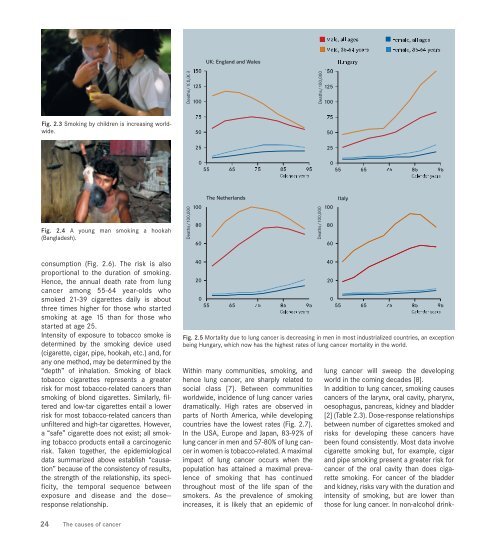world cancer report - iarc
world cancer report - iarc
world cancer report - iarc
Create successful ePaper yourself
Turn your PDF publications into a flip-book with our unique Google optimized e-Paper software.
Fig. 2.3 Smoking by children is increasing <strong>world</strong>wide.<br />
Fig. 2.4 A young man smoking a hookah<br />
(Bangladesh).<br />
consumption (Fig. 2.6). The risk is also<br />
proportional to the duration of smoking.<br />
Hence, the annual death rate from lung<br />
<strong>cancer</strong> among 55-64 year-olds who<br />
smoked 21-39 cigarettes daily is about<br />
three times higher for those who started<br />
smoking at age 15 than for those who<br />
started at age 25.<br />
Intensity of exposure to tobacco smoke is<br />
determined by the smoking device used<br />
(cigarette, cigar, pipe, hookah, etc.) and, for<br />
any one method, may be determined by the<br />
“depth” of inhalation. Smoking of black<br />
tobacco cigarettes represents a greater<br />
risk for most tobacco-related <strong>cancer</strong>s than<br />
smoking of blond cigarettes. Similarly, filtered<br />
and low-tar cigarettes entail a lower<br />
risk for most tobacco-related <strong>cancer</strong>s than<br />
unfiltered and high-tar cigarettes. However,<br />
a “safe” cigarette does not exist; all smoking<br />
tobacco products entail a carcinogenic<br />
risk. Taken together, the epidemiological<br />
data summarized above establish “causation”<br />
because of the consistency of results,<br />
the strength of the relationship, its specificity,<br />
the temporal sequence between<br />
exposure and disease and the dose—<br />
response relationship.<br />
24 The causes of <strong>cancer</strong><br />
Fig. 2.5 Mortality due to lung <strong>cancer</strong> is decreasing in men in most industrialized countries, an exception<br />
being Hungary, which now has the highest rates of lung <strong>cancer</strong> mortality in the <strong>world</strong>.<br />
Within many communities, smoking, and<br />
hence lung <strong>cancer</strong>, are sharply related to<br />
social class [7]. Between communities<br />
<strong>world</strong>wide, incidence of lung <strong>cancer</strong> varies<br />
dramatically. High rates are observed in<br />
parts of North America, while developing<br />
countries have the lowest rates (Fig. 2.7).<br />
In the USA, Europe and Japan, 83-92% of<br />
lung <strong>cancer</strong> in men and 57-80% of lung <strong>cancer</strong><br />
in women is tobacco-related. A maximal<br />
impact of lung <strong>cancer</strong> occurs when the<br />
population has attained a maximal prevalence<br />
of smoking that has continued<br />
throughout most of the life span of the<br />
smokers. As the prevalence of smoking<br />
increases, it is likely that an epidemic of<br />
lung <strong>cancer</strong> will sweep the developing<br />
<strong>world</strong> in the coming decades [8].<br />
In addition to lung <strong>cancer</strong>, smoking causes<br />
<strong>cancer</strong>s of the larynx, oral cavity, pharynx,<br />
oesophagus, pancreas, kidney and bladder<br />
[2] (Table 2.3). Dose-response relationships<br />
between number of cigarettes smoked and<br />
risks for developing these <strong>cancer</strong>s have<br />
been found consistently. Most data involve<br />
cigarette smoking but, for example, cigar<br />
and pipe smoking present a greater risk for<br />
<strong>cancer</strong> of the oral cavity than does cigarette<br />
smoking. For <strong>cancer</strong> of the bladder<br />
and kidney, risks vary with the duration and<br />
intensity of smoking, but are lower than<br />
those for lung <strong>cancer</strong>. In non-alcohol drink-

















